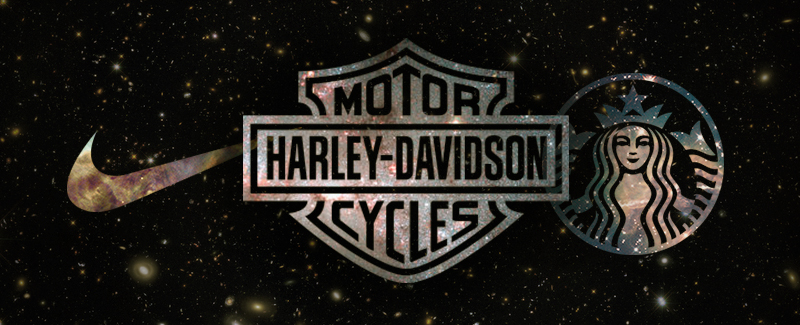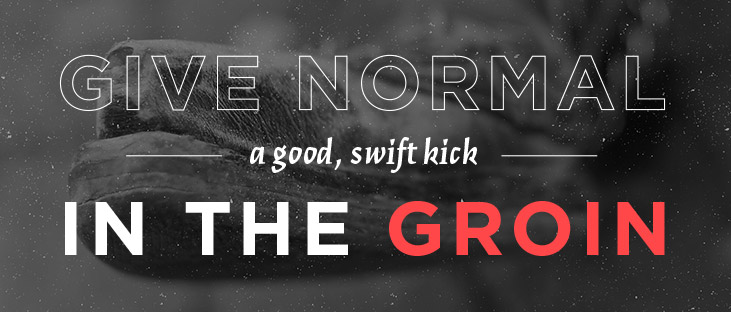 Branding
Branding
The Business of Branding. Who Rules the Universe?
Jim wakes up on a beautiful spring Saturday. On his way out the door, he laces up his favorite pair of Nikes. He admires the beautiful simplicity of the swoosh that is like a proud badge of honor. As he opens the door to the garage, he walks past the shoe caddy filled with numerous pairs of Nikes all selected for specific purposes — these are his riding pair. He opens the garage door and a flood of light fills the pristine room and bounces off the chrome of his pride and joy — a Harley-Davidson SuperLow 1200T. He swings on his leather Harley Riding Jacket and straddles the powerful machine. As the engine rumbles a rush of adrenaline and endorphins flood his system. Riding down the highway with the rhythmic passing of the dotted road lines whizzing by, Jim feels connected to the hog—they are one. His weekend journey wouldn’t be complete with a stop by his favorite caffeine pit stop: Starbucks. He parks his bike in his usual spot and heads inside. The smell of roasted beans is a familiar greeting, and his regular barista says, “Hey Jim! How are you today? Having the usual?” He acknowledges the order as he hands her his shiny gold Starbucks card. As he moves down the aisle, a white cup with his name on it is slid across the counter. Jim smiles as he takes his seat, enjoys the newest Neil Young track playing in the background and sips his triple venti soy no-foam latte. To say the least, these brands have made a loyalist out of Jim — but how’d they do it?
Nike | Dominant Position
Nike is not just a shoe company. They are an aspirational athletic and fitness company. With their famous Swoosh, Nike is one of the most recognizable brands in the world. Their commitment to branding has made Nike one of the most highly valued and most successful brands today. A brand should encompass much more than the product or service. A truly remarkable brand should give consumers something to identify with and give the product substance and meaning. Take it from Nike, whose success and dominance in the world of sports has thrived on their ability to construct their brand image, visibility and giving the company an extremely dominant position on the marketplace. Nike has fostered this dominance with strategic celebrity endorsers, such as Michael Jordan. The idea is that the celebrity image is embedded into the consumer’s mind and will cause the consumer to identify with Nike’s products, making the brand more desirable and valuable. The sports celebrities convey the idea of athleticism and become a heroic, iconic symbol people strive to become. When consumers translate these ideologies Nike builds incredible value. We’ve worked with Nike developing their line of Tiger Woods golf products, so we understand Nike’s commitment to branding first hand. Nike spends around 3 percent of its annual revenues on capital expenditures, whereas spending on the business of branding—keeping their brand visible—is about 10 percent of annual revenues. When it comes to dominance in the marketplace, no one does it better than Nike. They have re-defined the power of a brand image and are one of the best represented, culturally understood and symbolic companies in the United States and in the history of sports.
Harley-Davidson | Highest Premium
As an American icon, Harley has come to symbolize freedom, rugged individualism, excitement and a sense of “bad boy rebellion.” Harley’s brand reflects things many Americans dream about. They’re a little bit naughty and a little bit nice, which is a very attractive brand image to have. Harley riders like the awe the bikes inspire at stoplights or when groups ride into small towns. Many Harley owners and employees feel such a bond to their bikes that they have a weakness for tattoos of the company’s logo. Harley has marketed this emotion across socioeconomic strata, from blue-collar craftsmen and bearded, beer-bellied “motorheads” to a growing legion of chief executives, investment bankers and high-profile entertainers, including Arnold Schwarzenegger, Jay Leno and Billy Joel. And it’s the passion behind the brand that explains how Harley has been able to cross so many socioeconomic boundaries. Its owners are buying much more than a mode of transportation. What bonds them to the bikes—and ultimately to each other, at rallies and other events—is a mutual appreciation of the look, feel and sound of the machines. Foreign competitors like Honda, Kawasaki, Suzuki and Yamaha have taken straight aim at the heavyweight. And while they have captured a bit of the market by producing high-quality less-expensive machines that look and sound something like Harleys, they have been unable to match the Harley brand mystique. The company now regularly reports record sales and earnings each year. Harley has quadrupled production in the past decade but still can’t keep up with all the orders. How can they command such a high premium and still blow away the competition? A relentless and passionate commitment to the business of branding.
Starbucks | Avoiding Commoditization
Have you ever observed the people going in and out of Starbucks? Some just come in to grab a quick cup of coffee, but most are there for more: a first date, a study session, a work meeting or a break away from the chaos of the world. Regardless, it’s a purpose that is clearly more than a cup of coffee. From a branding standpoint, Starbucks offers a unique experience from the gas station coffee counter. Starbucks’ story is particularly remarkable because they’ve harnessed the power of branding to turn one of the world’s most pedestrian beverages and second leading commodity (behind oil) into a premium product, wrapped in a carefully cultivated, widely recognized brand name that extends far beyond what’s in the cup. It is a brand that’s defined as much by attitude as it is by products. The Starbucks “experience” is about more than a daily espresso infusion. It is about immersion in a politically correct, cultured refuge from everyday hassles. Starbucks has grown to become one of the most talked-about brands in American culture. Their stores are decorated with bins of coffee beans, photos of coffee trees and shelves of gleaming coffee paraphernalia. Employees are trained to educate customers about what they were drinking and why it tastes good. For many, the experience is so engaging that Starbucks becomes a natural gathering place, and that made the brand familiar. Through a relentless commitment to branding, these companies have been able to achieve dominant positions in their market, command the highest premiums and rise above commoditization. For the brands that have managed to achieve this loyalty beyond reason, their prosperity has sewn them into popular culture and helped fashion them into icons of their time.


